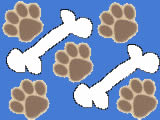Why Does My Dog Eat Feces?
Dogs will sometimes eat their own feces. Others are attracted to feces from other animals, such as cats, horses and deer. The reasons range from a vitamin deficiency to boredom or anxiety. The scientific name for this behavior is coprophagy. If your dog eats feces, be sure to report this to your vet. Even though it's very common, it's one of the behaviors associated with rabies, and there are health risks for stool-eating dogs. They can infect themselves with parasites, such as giardia, Filaroides, or coccidian. If the feces are around for two to three weeks or more, roundworms and whipworms may be present. Here are some suggestions for solving this problem:
Use that pooper-scooper!
Besides some of the other solutions you can try to your dog from eating his own feces, one of the best is to pick up all fecal matter before your pet can get to it. Your dog can't eat something that is not there.
Is the dog hungry?
One simple explanation to this problem might be that your dog is hungry. Try increasing the frequency of feedings. If you usually give a meal once a day, try splitting the portion and give food twice each day for about a week and see if that stops the behavior.
Give your dog lots of room
Generally speaking, dogs don't like to sleep or live too close to where they defecate. If they're being kept on a dog run or in a laundry room that's too small, they may eat their feces just to keep their space clean. If your puppy or dog is exhibiting this behavior and you keep him in a rather confined area, you may be able to put an end to it by giving him a little more living space.
Try a tasty treat
If your dog eats his feces while on leash while you're out walking, you might need to use some diversionary tactics to break the habit. Take some doggy treats with you and after your dog does his business, and before he can turn around and eat it, distract with a treat and have the dog take a couple steps forward. While the dog is busy eating the treat, clean up the mess. If your dog eats other feces it finds while out on walks, you may have to use a muzzle until you find a solution to the problem.
Doesn't that taste awful enough?
There are commercial products, that when put on a dog's food, supposedly produces a stool with an unpleasant taste. Other products used are MSG (monosodium glutamate), Bitter Apple, hot sauce or cayenne pepper. Unfortunately, none of these products have been consistently successful in getting rid of the problem. Before using any of these products, check with your veterinarian. Your vet might be able to suggest something other patients have found success with.
Kitty tootsie rolls
There probably isn't a dog around that wouldn't grab a quick snack from the cat's litter box if given half a chance, much to our disgust! That's because cat food, and therefore cat feces, is very rich. If you're able, clean out the litter box right after your cat uses it. But if you can't watch over the litter box, make it inaccessible to your dog by applying a hooded litter cover, placing the box on an elevated surface, or placing the box in a room with a cat door or leaving the door open just enough to allow the cat to get in, but not the dog. You can also try putting a baby gate around the kitty litter box that has an opening big enough for your cat, but is too small for the dog.
Quality Time
Increase the time you spend playing with and exercising your dog. Provide a wide variety of appropriate chewing objects. Some dogs learn that eating feces is a way to get attention, even if it is negative attention. As difficult as it may be, ignore your dog if you catch him or her in the act and don't scold. Instead, concentrate on preventing it next time.
Many dogs learn not to show this behavior when their owners are present, but will wait until they are alone. Punishment after the fact is NEVER helpful. Animals do not understand they are being punished for something they did hours, minutes or even seconds before. This will not resolve the problem and is likely to produce either fearful or aggressive responses from your dog. In addition to consulting your vet, you may want to consult with a behavioral specialist who can teach you a variety of behavior modification techniques that might help resolve the problem.






